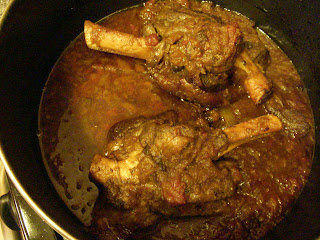This sausage project started because of Dave’s monthly card game with his buddies. He hosted it a few weeks ago and I made them Italian sausages with peppers and onions for dinner, and had mixed the peppers and onions into a homemade tomato sauce. Dave wanted more, he loved it. And we’ve been getting piles of bell peppers in our CSA basket, I can’t eat them, and we needed a way to not waste them. This week I made more than a gallon of homemade marinara with roasted peppers and onions, which has gone into freezer containers. It just seemed like it would be fun to make our own sausage for it, especially since I have a lot of fresh sage right now.
We then picked up a whole boneless pork butt, this one was a little smaller than I usually get, only ten pounds. Certainly enough for plenty of sausage, though! I started making sausages after I took a class at Culinary Communion a couple of years ago. Then I bought “Charcuterie” by Ruhlman and Polcyn, a great reference book for so many things preserved. I made their Italian sausage recipe the first time, probably two years ago. Since then I have tuned the seasonings and method, doing my usual literature surveys in my collection and online. And before anyone emails me about this, yes, I know that “true” Italian sausage doesn’t have paprika, parsley, and anise seed, at least to the purists. However, I don’t think there’s anything wrong with improving flavor. I use a heavy-duty KitchenAid mixer for this, with grinder and sausage stuffer attachments. You can use a hand grinder, too. If you use ground pork from your butcher, be sure to beat the seasoned pork to develop the myocin as described in the first paragraph of the recipe – your results will be so much better, even if you are only making a breakfast sausage with salt, sage, and pepper.
Shelly’s Italian-style Sausage
Three pounds of pork butt, cut into ½” dice (do not trim fat off!)
½ t anise seed
1 ½ t black peppercorns
4 t fennel seed
4 t salt
1 T minced fresh sage (or 1 t dried)
2 t hot paprika
2 t sweet paprika
2 T puréed fresh garlic
1 ½ T chopped parsley
2 oz dry red wine
About 5 feet of hog or artificial casings, if you want sausage links, cut into 3- to 4-foot lengths
Grind anise and peppercorns together, then add the fennel seed and crush it but don’t grind it to a powder. I use a mortar and pestle for this but can be done in a spice grinder or coffee grinder, of course. Add all ingredients to the pork and mix thoroughly. Refrigerate overnight. Next day, run the pork through a grinder with the medium plate. Grind it into a bowl set in another bowl filled with ice. It is important to keep the fat cold, if it melts your sausage will have a curdled texture and the fat will all drain away when you cook it, leaving it dry and with a lot less flavor. Fry about an ounce and taste to check for seasonings. Adjust as needed. Then either in one big bowl with your hands or a wooden spoon, or in batches in a heavy-duty mixer with the paddle attachment, beat the meat until you see it get sticky and it looks like threads are developing in it. This process develops a protein in the meat called myocin, and it’s what makes sausage more than just some seasoned ground meat. The myocin gives the sausage a smoother texture and helps it hold together instead of being crumbly. Do not skip this step if you want really good sausage! Put the sausage back into the refrigerator for an hour or so until it is cold again.
In the meantime, if you are making links prepare the casings according to the instructions on the package. If there are no instructions, soak natural casings in cold water for about an hour until they are soft, then run water through the casings. Set up your sausage grinder with a stuffing tube, great the outside of the tube, and feed a couple of the lengths of casing onto it. Pull the casing until you have about 2 inches hanging off of the end of the stuffing tube. Do not tie this off. Cut yourself twice as many 4” pieces of kitchen twine as you have pieces of casing. Put a big sheet pan under the stuffing tube and rub about a tablespoon of water across this. The water makes the sausage slide easily on the pan while it rests as it comes off the stuffer. Start feeding the pork into your stuffer, and stop as soon as the meat begins to appear in the casing. With your fingers, smooth the casing over the meat and push out any air from the end of the casing. Then tie off the end of the casing next to the meat. Continue to feed pork into the stuffer, making sure the casing is evenly filled but not stretched as tight as it will go – you’ll need a little bit of give to twist the links. The sausage will be about 1 ¼” in diameter as it comes off the stuffing tube. When you can see that you have about two inches of casing left on the tube, stop feeding and gently ease the end of the sausage off the tube. While the sausage sits on the sheet pan, smooth out any uneven spots, and then squeeze all the air out of the open end of the casing and then tie it off with one of your pieces of kitchen twine. Continue with the rest of the pork and the casings.
To twist the sausage into links, begin from the left end of the sausage. Move your left hand in six inches (or as long as you want your links) in from one end, and place your right hand the same distance farther in on the sausage. Squeeze with your thumb and forefinger on both hands to divide the sausage, then grasp the link that is between your hands and twist it toward you two times. Move your left hand six inches in from the rightmost twist, and your right hand six inches to the right of your left hand. Once again squeeze your thumbs and forefingers together to divide the sausage, but this time twist the link away from you two time. Repeat this process, twisting toward you the next time and away from you the time after that.
Of course, you can just form the sausage into logs, wrap them in plastic and chill, then freeze them and slice off what you need in patties, or make patties and freeze them on a sheet pan then put into freezer bags.
Store the sausage in the refrigerator overnight before cooking. The sausage will keep about three days refrigerated or a month or two frozen. When you cook them, cook to an internal temperature of about 160-165 degrees. I put them in a skillet with six ounces of water, and cover to steam them gently for about 15 minutes, then uncover and brown them or put them on a grill.
(recipe copyright 2008, Vivian R. Johnsen)




















 I think we’re having grilled chicken on salad today.
I think we’re having grilled chicken on salad today.
 :
:


